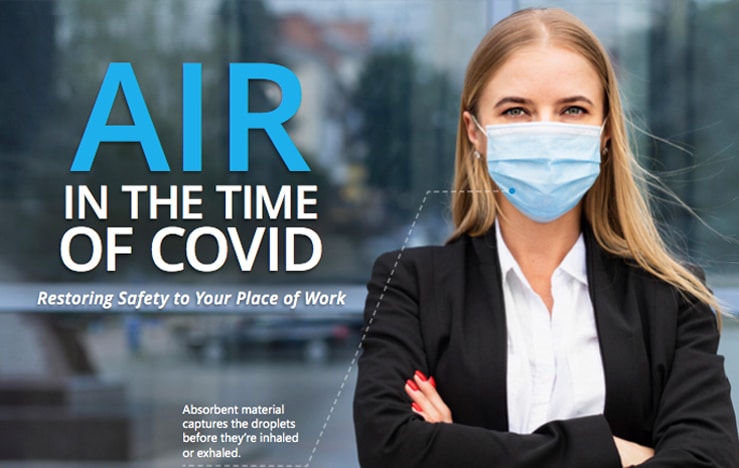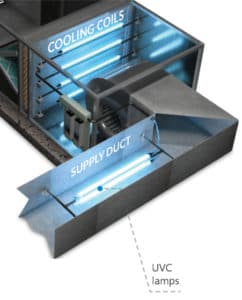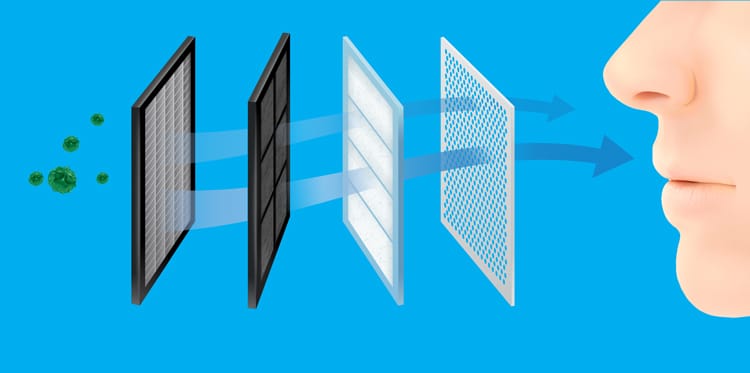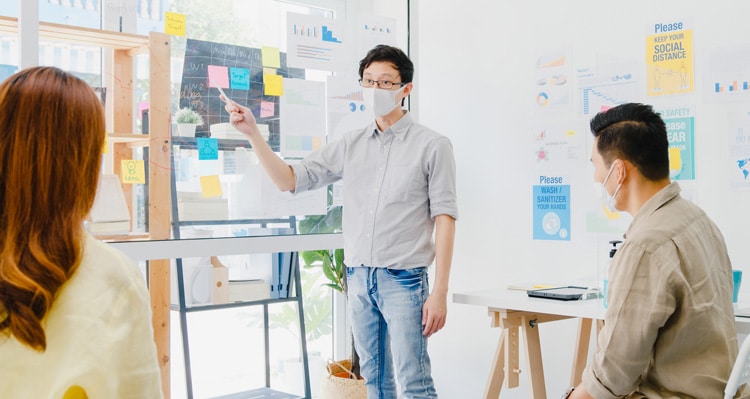Air in the Time of COVID: Restoring Safety to Your Place of Work
In the wake of the COVID-19 pandemic, how can businesses safely resume work?
How can building managers safely bring back workforces of office personnel and factory floor staff?
What steps provide safety and demonstrate proper diligence on the part of management?

Respiratory Viruses: What are the Risks?
COVID-19, like influenza and many other infectious diseases, is spread by aerosol. Most respiratory viruses can’t survive in dry air. They need to be suspended in liquid, even if the droplets are too small for the eye to see. Air gives the virus mobility and gives it a path to the sinus cavities and lungs of potential victims. The key to protection, therefore, lies in the air.
Mask requirements and social distancing rules reflect this. Masks aren’t airtight, but they are made of absorbent material that captures the droplets before they’re inhaled (or exhaled). Droplets are heavier than air; social distancing gives those droplets time to sink below the zone of inhalation, reducing the chance they’ll enter someone’s lungs.
Sunlight (and UVC) is the Best Disinfectant
The airborne droplet model gives us other chances at facing and defeating the virus. COVID-19 and influenza rely on RNA to encode their genetic information. RNA is more delicate than our own DNA, and can be disrupted or destroyed by exposure to ultraviolet light. Sunlight includes UV rays, which is one reason why outdoor exposure is considered less dangerous than indoors.
A particular wavelength of ultraviolet, called UVC, is particularly good at damaging RNA. UVC lamps have been used for decades to disinfect the air in surgical rooms. This technology is readily available and easily affordable. UVC is too powerful to allow people to be exposed, but installing UVC lamps in ductwork and air handlers is straightforward and can be done without risking human exposure. As air from the building is drawn over the UVC lamps, the rays break up the RNA of the virus, degrading its ability to infect.
Ventilation: Dilution is the Solution to Indoor Air Pollution
Ventilation is also a powerful tool to protect our workforce. There are several benefits to good ventilation. By bringing in outside air, a good ventilation system dilutes and displaces indoor air that may contain aerosol droplets. Ventilation also promotes air movement, and moving air has a higher rate of evaporation than stagnant air. For example, sheets on a clothesline dry more quickly in a breeze than on a calm day. Greater evaporation means that the liquid that makes up aerosol droplets converts to water vapor, which can’t sustain the virus. The droplets shrink and vanish, killing the viral particles. Finally, ventilation reduces space humidity. Evidence shows that viruses thrive best in a narrow range of humidification.
California’s ambient air generally has lower levels of humidity than the preferred range for the virus. Reducing indoor humidity makes things harder on the virus, decreasing the risk of infection.
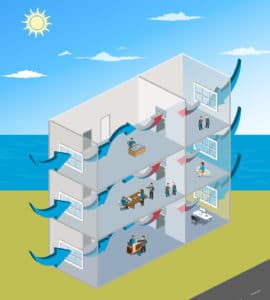
- Bathrooms must have exhaust fans
- Air conditioning systems must deliver outside air
- HVAC equipment must include components called “economizers.” These devices increase outdoor air intake on mild days. This reduces run times on air conditioning equipment and provides yet more fresh air.
Unfortunately, many building managers aren’t aware of the code requirements for ventilation. And, their HVAC service providers don’t keep them informed. In some cases, either the manager or their HVAC company has closed off outside air intakes or disabled the economizers. During heat waves, bringing in 100° air makes it harder to keep a building cool. Sometimes a repair technician will block off outside air under such conditions. Then, they never get around to restoring it once the heat eases up. Economizers are also notorious for being fragile. Sensors fail, linkages break or damper motors seize up.
Ventilation Maintenance
The proper thing to do is make sure all your outdoor air intakes are open and your economizers are in good working order. Schedule a technician out just to confirm these are functioning appropriately. Regular maintenance is always a good idea. But, it is particularly important now, when concerns about indoor air quality are at all-time highs. Outside air is vital to keeping your building and its inhabitants healthy at all times. And, it’s a key component in getting your workspace ready to resume work.
Filtration: Gotta Catch’em All
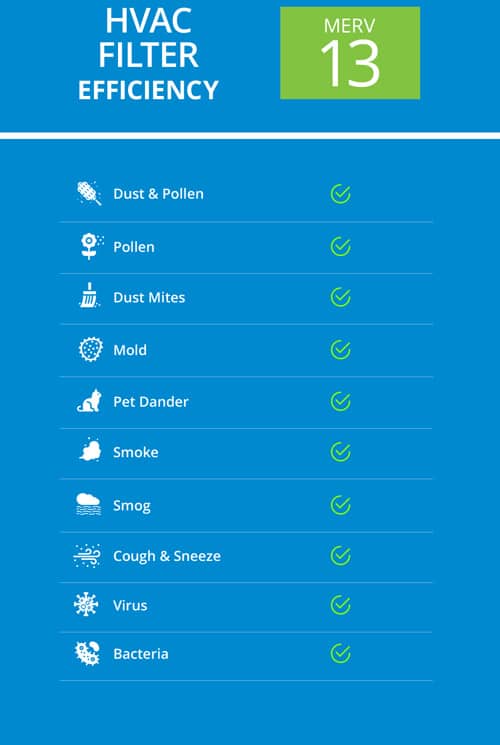
HVAC blowers can load up with dirt and debris, degrading their ability to move air. Filtration prevents that. But the dirt that loads up blower wheels is much larger than the particles that make indoor air unhealthy. And standard filters do nothing to stop the aerosol droplets that entrain viruses and bacteria. For that, you need MERV13 filters.
The American Society of Heating, Refrigeration and Air conditioning Engineers (ASHRAE) rates filters by the size of particulate the filter can trap. This Minimum Effective Reporting Value (MERV) ranges from 1 to 20. A MERV1 filter is a standard model, capable of catching dust and hair but not much else. Higher ratings translate into smaller particles. ASHRAE rates MERV13 filters as small enough to capture aerosol droplets and recommends their use for general surgery and other health-sensitive applications.
There is a class of filter called HEPA (High-Efficiency Particulate Air) that can capture actual virus particles. But HEPA filters use a medium so dense that most HVAC blowers can’t generate enough pressure against them to push air through the medium. HEPA systems need their own dedicated blower, and even then can only filter a small volume of air. Needless to say, they are expensive to install, and the low volume of filtered air makes them better suited to use in a single room rather than in an entire building.
Belt, Suspenders AND Buttons
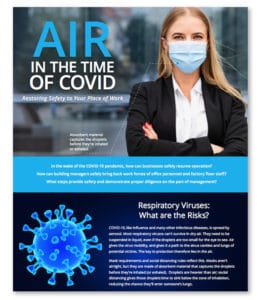
Of course, the best approach is to use a combination of UV radiation, ventilation and filtration to provide a safe work environment for your staff. Once you’ve designed a plan to make your building ready, stick to it. All of these tools require regular maintenance to keep them working effectively.
UV lamps and HVAC filters need regular replacement. Economizers need inspection and testing to confirm good operation. Make sure you have a knowledgeable HVAC professional visiting regularly to keep things in good working order. Then you know you can invite your co-workers inside with the comforting knowledge that you’ve taken every practical step to give them a safe workspace.
Need help restoring safety to your place of work?
The experts at Air-Tro Inc. can help you with a solution.

